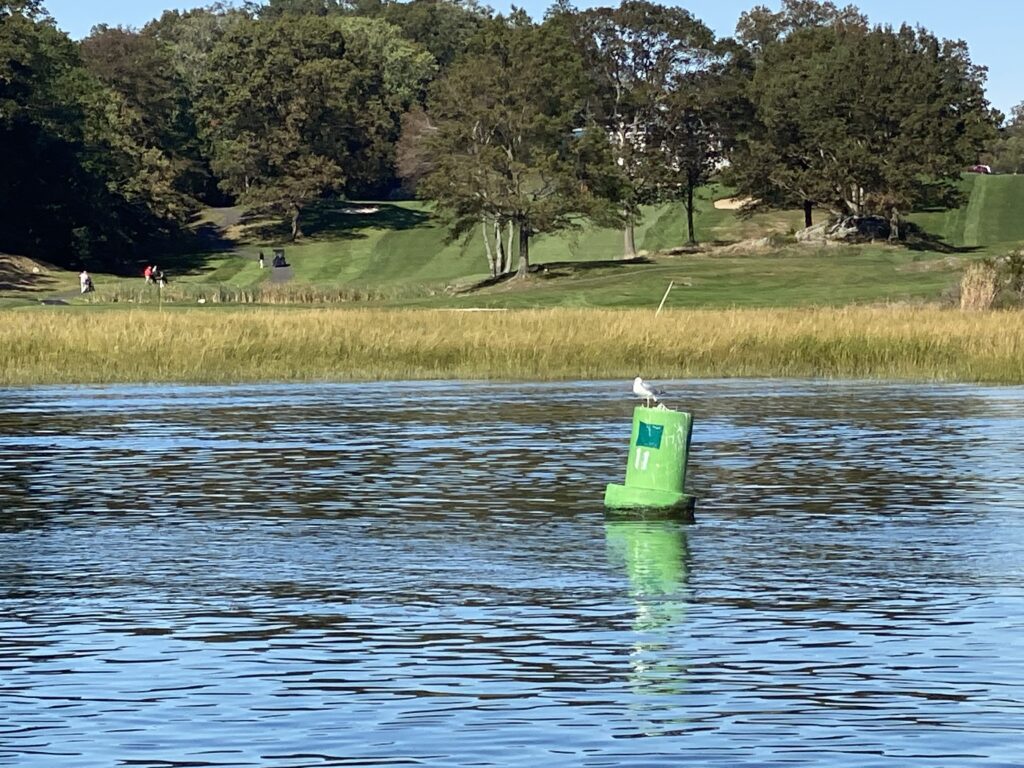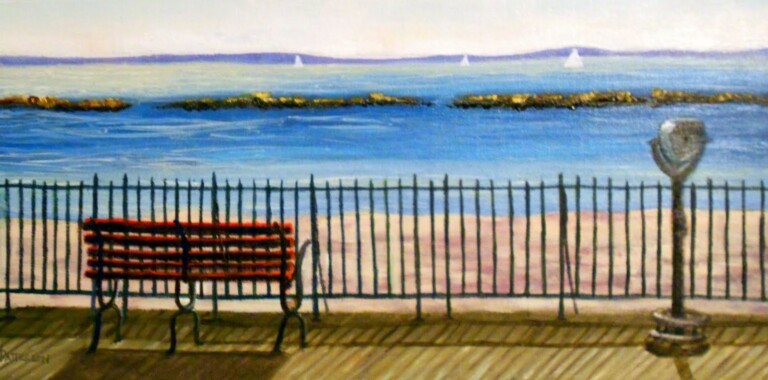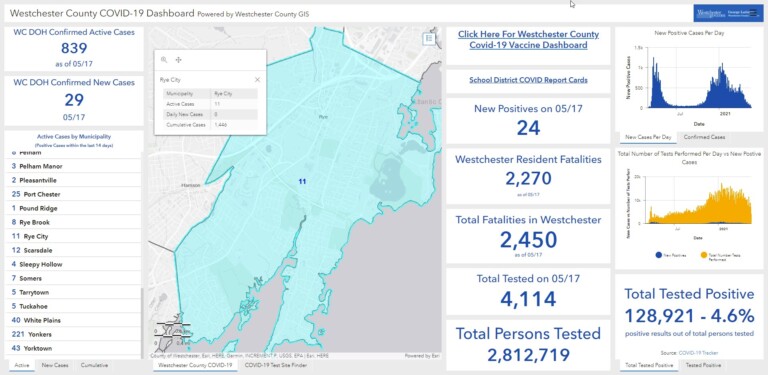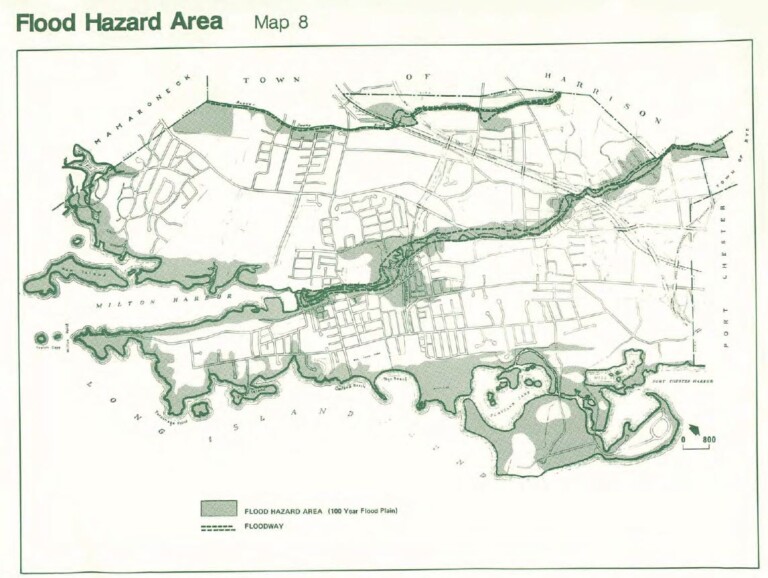Muddy Waters: Coast Guard Proposes Removing Navigational Buoys from Milton Harbor
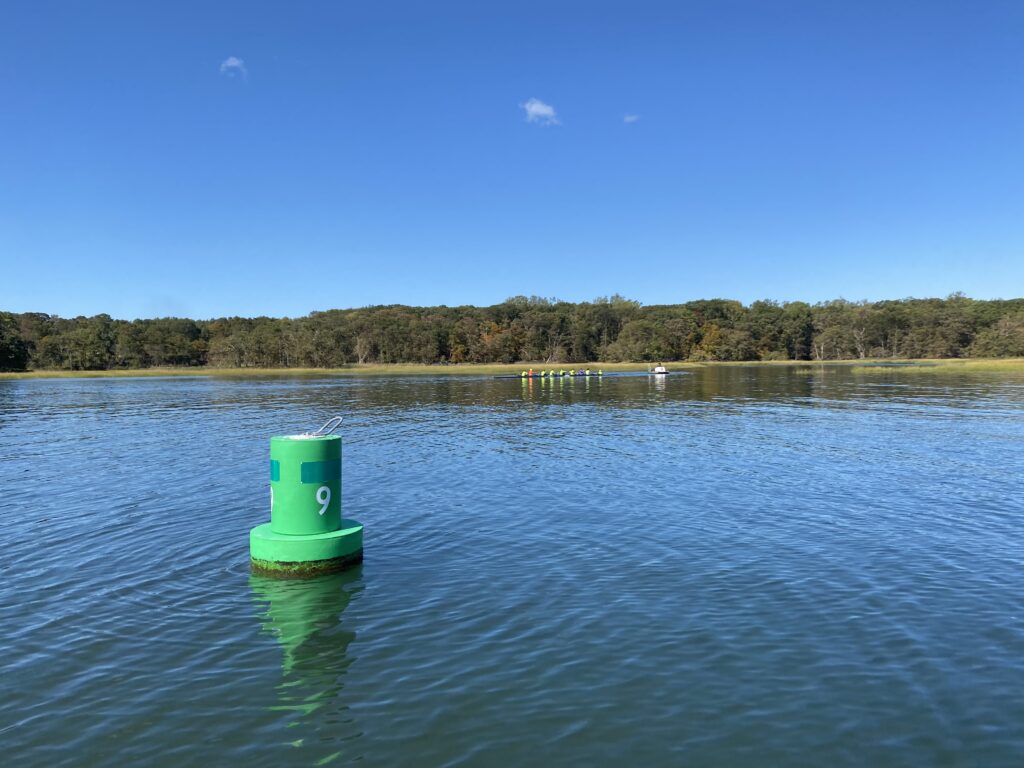
[Note: see an update to this story posted February 7th, 2022.]
The US Coast Guard is proposing the removal of all ten navigational buoys in Rye’s Milton Harbor. Unless halted, the move threatens the harbor’s designation as a federal channel—and a corresponding array of federal funding that helps maintain the waterway.
Local advocates say over 5,000 people use the harbor – including people from private clubs and residential docks to families enjoying over 1,200 boats. Perhaps most alarmed should be local realtors who routinely trade on Rye’s waterfront access. That access is now becoming silted and unnavigable.
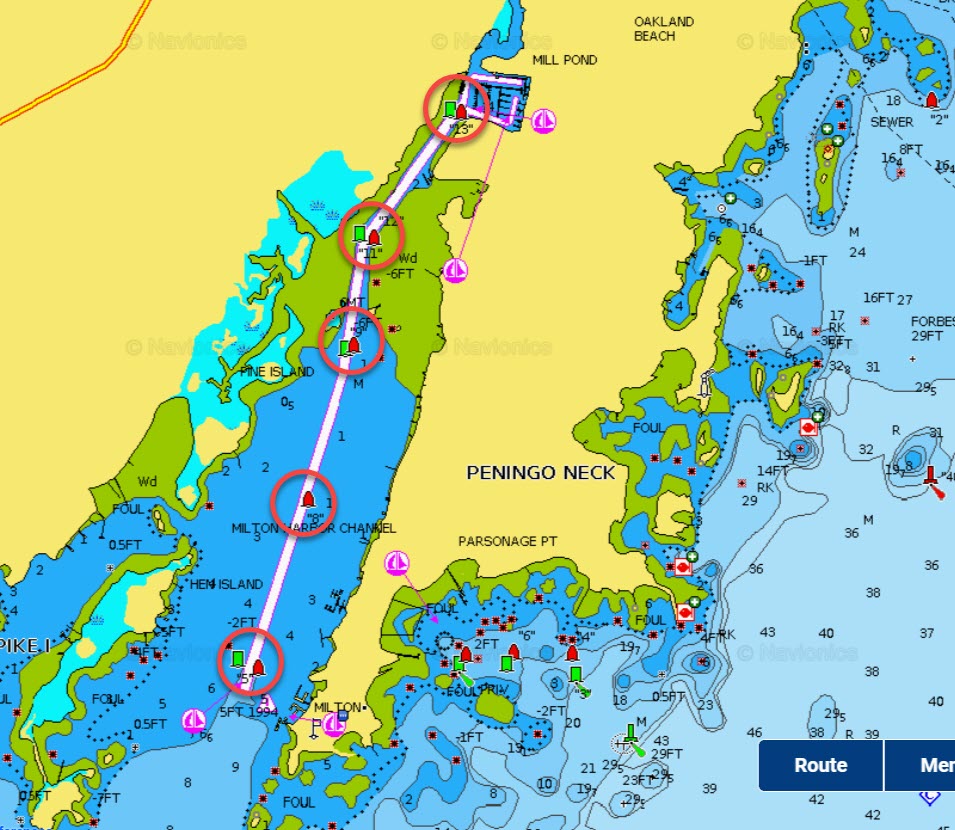
“This is the first step in trying to undesignate this as a federal channel,” said Joe Pecora, chair of the Boat Basin Commission. “And when that happens, we’ll never ever have a chance of any funding.”
Another critical player is the United States Army Corps of Engineers (USACE). It is the USACE that typically makes a waterway navigable in the first place, and then the United States Coast Guard (USCG) that establishes and maintains the navigational aids.
The USCG is soliciting comments on its proposal before February 11th. The issue is closely related to the long-standing need to dredge the harbor, an already urgent need only exacerbated by additional debris brought by Hurricane Ida this past September.
US Army Corps and Channel Dredging
In the last number of years, the USACE adopted new policies saying it was no longer going to maintain federal channels that do not have commercial traffic.
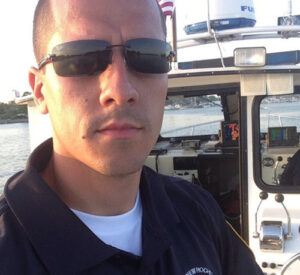
“The last time they dredged the channel was over 10 years ago,” said the City of Rye Boat Basin Supervisor Rodrigo Paulino, CMM. “Now the city is struggling with how we’re going to come up with the money not only to dredge the marina, but now to dredge the channel which we’ve never had to do in the past.”
The city has always been responsible for dredging the marina–a significant expense in and of itself–but now faces the cost of dredging the marina and the channel from the boat basin out to the end of Milton Point. With lower navigational depths because of silting, the USCG is now making its proposal to remove its buoys.
Who Pays? The Boat Basin’s Enterprise Fund or the City of Rye
The Rye Boat Basin operates as an enterprise fund, separate from the City of Rye. Currently, it looks like the Boat Basin enterprise fund will take the financial responsibility for the boat basin dredging and the City of Rye will foot the tab for Milton Harbor channel.
Permits have been submitted to the USACE (they no longer do the dredging but still need to approve it) and the New York and Connecticut DEC (some silt will be dumped into Connecticut waters). Work on dredging could start as soon as November.
While the silt from the channel is clean, the silt in the marina is contaminated (with pollution such as fuels, salts, bottom paints and other goodies that come down the Blind Brook), driving up costs significantly. This polluted silt cannot be dumped off shore and needs to go to a special plant for remediation.
The Cost
It is expected to cost between $1.5 and $2 million to dredge the channel but $5-6 million to do a full dredge of the marina (due to the contamination issues). The Boat Basin may be forced to do a partial / 80% dredge to reduce costs to $3-4 million. But that will mean a “maintenance dredge” in just a few years.
No matter the cost, it is expected the City will need to float a bond to raise the funds. It would loan funds to the Boat Basin with the expectation for the loan to be paid off in three to five years.
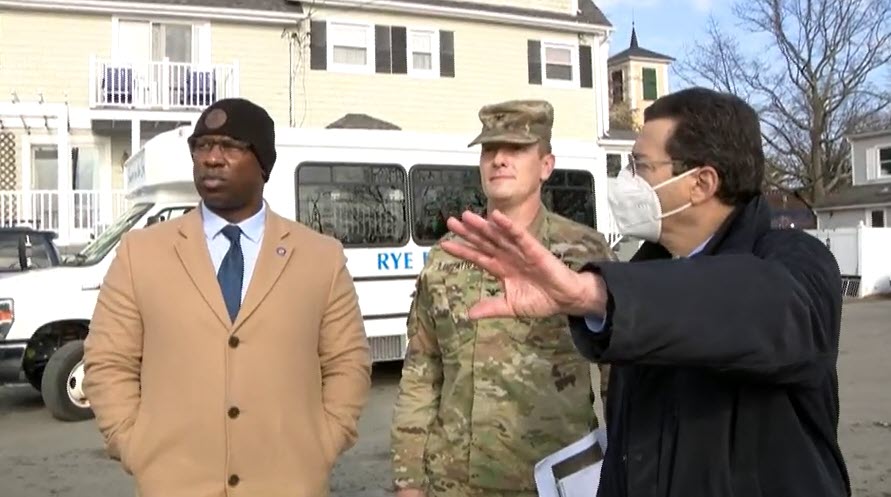
The City and the Boat Basin is also looking for FEMA money to help with the dredging in the wake of Hurricane Ida contributing to the silting. If secured, the money could allow for the dredging to six feet, meeting the minimum USCG requirements for maintaining navigational aids. The Army Corps along with Rye’s Congressman Jamaal Bowman toured Rye just last Monday to see the damage from Ida.
“Now with this infrastructure bill, maybe we really lobby to get the [US Army] Corps to do this every 20 years, every 25 years,” said Pecora, the Boat Basin chair, working to sound hopeful. “And then we just maintain it … we can do that easily.”
USCG Buoy Removal
In the wake of all the planning to dredge the channel, the Coast Guard floated its proposal to remove the ten buoys in its weekly Local Notice to Mariners on January 22nd.

“No one wants to lose their navigation,” said Senior Chief Petty Officer Joey Bucciero, Officer in Charge of USCG Aids to Navigation Team New York. “We relocate the aids [aids to navigation–the buoys] to follow the shoals to make sure that mariners can still transit those waterways safely and we’ve moved them so much to the point where right now maybe one boat can pass.
“What we’re trying to prevent is [a boater] from cruising through there and next thing you know, there is no water, they get ejected from their boat, they break their back and they drown. If there is not enough water to mark to say it’s safe, then the Coast Guard doesn’t have any option but to disestablish the aids to navigation.”
“If this happens number one, we’re ready to proceed with private [buoy] markers if need be so the harbor is always marked,” said Boat Basin Supervisor Paulino. “But obviously I think this will be a step backwards for Rye so we’re obviously fighting this and this going all the way up to Senators.”
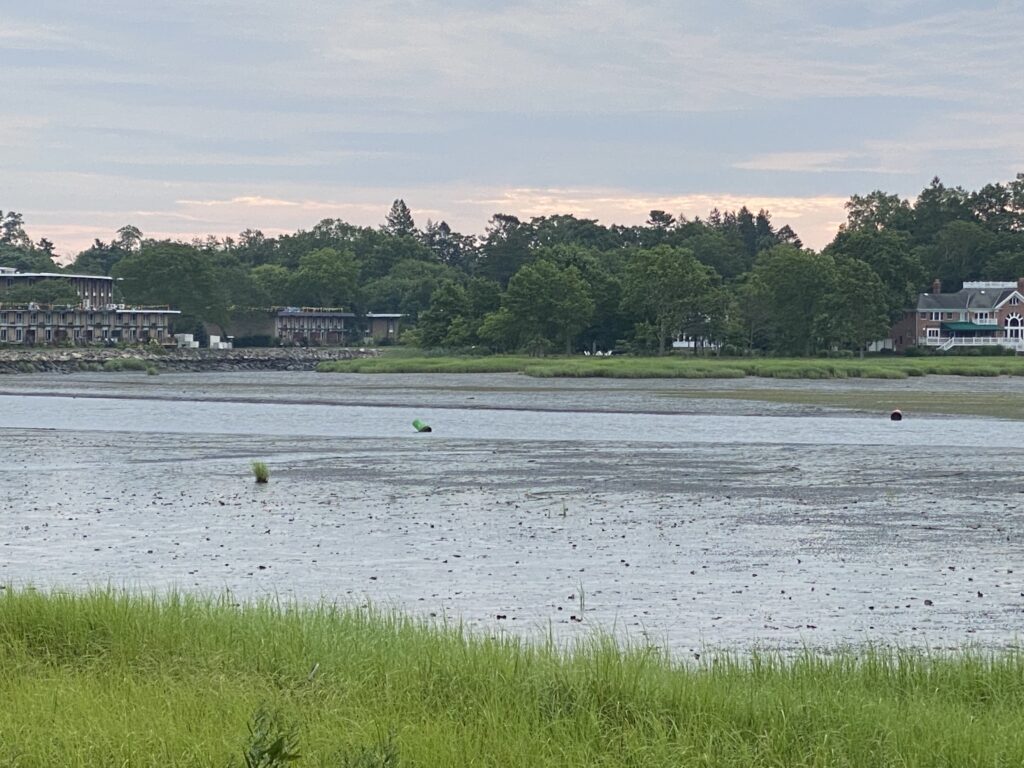
The Coast Guard seems unlikely to wait for the channel to be improved by dredging this winter. An additional complication is the current plan is to dredge the channel to five feet (limited due to cost) but the USCG requires six feet to install and maintain its navigational buoys, meaning it is unlikely the Coast Guard will consider reinstalling the buoys after they are removed.
Also murky is what the Coast Guard deems as sufficient commercial use that would warrant maintaining buoys. Right now the Boat Basin is primarily for pleasure boating. Commercial and other critical operations include Carefree Boat Club rentals, two sewage pump out stations for boaters and the State DEC and Rye first responder boats in the boat basin and RowAmerica Rye tucked right next door.
“We don’t have any fishing vessels or anything like that,” said Basin Supervisor Paulino. “I think that would help. Another thing we are looking at is adding fuel to the marina. Once you add fuel you have to be open to the public and your channel has to be dredged to make sure the public can come in and fuel up.”
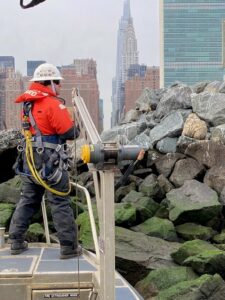
“Typically, the more viable a waterway is, the more attention it gets, the more dredging it gets, the more money it gets to maintain the channel and then obviously the Coast Guard marks it,” said the Coast Guard’s Bucciero. “It’s not the Coast Guard or the Army Corps or the federal government’s job to maintain a waterway to keep people’s property value up because they can access it by water. That’s not our responsibility. The local municipality can do that. And a marina can try to co-op costs locally to maintain their waterway that they use.”
The Coast Guard itself has run aground in Milton Harbor. “I was on the boat,” said Bucciero. “We ran aground out there when we went to go pick up a couple of our buoys that broke free because they were sitting on the bottom and they broke free from the channel.”
What’s Next?
The Coast Guard will process the public comments after the February 11th deadline but the timing of any final decision to remove the Milton Harbor buoys is not clear. Rye City Council is expected to vote on funding for dredging in the spring or summer.
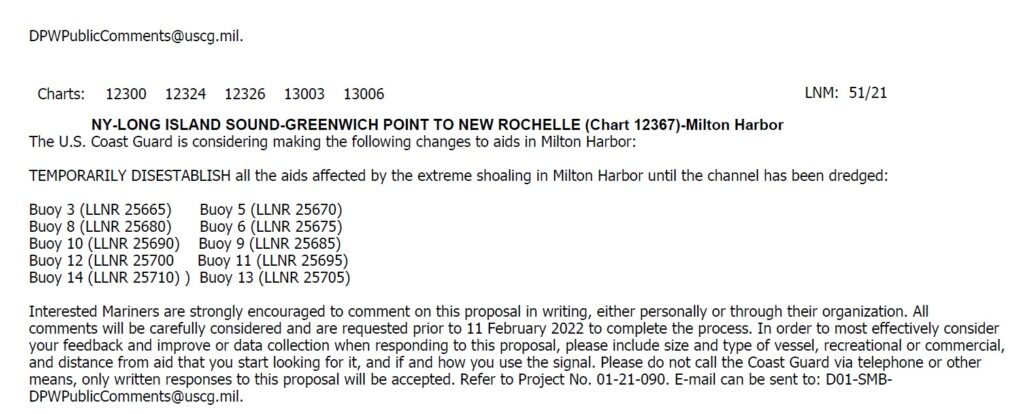
“I just need to stress the importance of a community getting together to let them [the USCG] know that they want this harbor,” said Pecora, the Boat Basin chair. “It doesn’t only affect the people that actually use it. It really equates to people’s property values. When people come to buy a home in Rye, all the realtors are showing the golf club, the marina … we are a sound shore community. This is everybody’s problem and I can’t imagine many people wanting to see this go away.”
It seems various voices of advocacy from local mariners and others that enjoy our local waterfront will need to advance the cause of dredging and navigable waters. Politics is a murky business, but it seems necessary if residents expect clear and navigable waters ahead.
